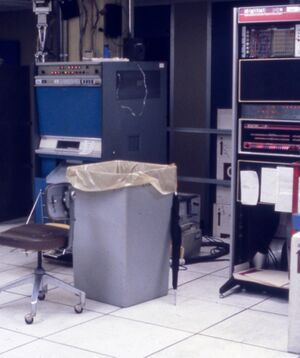Xerox Graphics Printer
The Xerox Graphics Printer (usually given as the acronym, XGP) was the earliest raster printer, and thus the ancestor of the ubiquitous laser printer.
It used the xerographic printing process developed by Xerox for copiers: a drum of photovoltaic material holds an electrostatic charge in darkness, and will conduct away that charge when light is shone on it; that electrostatic charge will hold powdered ink ('toner') on the drum until the ink can be melted onto a piece of paper by heat from the 'fuser'. Thus, a light source can 'draw' images in the static patterns on the drum, which then holds the powdered ink until it is applied to the paper.
The XGP was based on the Xerox LDX (Long Distance Xerography), a facsimile system which came out in 1964, and used a raster scan of the original document. Both the LDX and the XGP used a CRT as the light source. For the XGP, the scanner was dispensed with, and the printer was attached to a computer, which produced the rasters directly. The XGP had a resolution of 192 dots to the inch; it printed on paper unrolled from a large roll of paper, and it had a knife to cut off pages, which could be actuated by the controlling computer.
Xerox provided XGP's to a number of universities and research institutes by 1972, including MIT, Stanford, Carnegie-Mellon, ISI, Caltech, and University of Toronto; each of which produced its own hardware computer interfaces, and software to drive it. MIT and Carnegie-Mellon both used PDP-11's to drive their XGP's, but it is not known how much there was any design connection between the two (although the similarity of the specifications of the two interfaces make it plausible that there was some knowledge exchange).
The one at MIT was connected to the ITS KA10 MIT-AI via the Rubin 10-11 interface, and it remained the mainstay of printing at Technology Square until Xerox PARC donated a Dover printer (one of the first laser printers) to MIT.
See also
External links
- Flashback Fridays: Looking Back in Time at Xerox History - covers the LDX (the image of the printer unit shows it looking much like an XGP)
- An Experiment in Library Application of Xerox LDX Facsimile Transmission Equipment - Appendix I, "LDX Equipment Specifications", gives detail on the LDX
- Marking 40 Years of Xerox Laser Printing With Its Inventor Gary Starkweather - mentions his work with the LDX
- Workshop on Hard Copy Line Graphics - details of the XGP installation at CMU
- XCRIBL - A Hardcopy Scan Line Graphics System for Document Generation, by R. Reddy, B. Broadley, L. Erman, J. Newcomer, G. Robertson and J. Wright.
- XGP - Xerox graphics printer - includes images of XGP's
- XGP (Xerox Graphics Printer) in MIT AI Lab - MIT's XGP (center)
- XGP > - PDP-11 code to run MIT XGP
